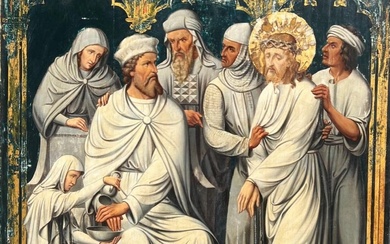Follower of Hans Holbein. Portrait of Erasmus, circa 1550, oil on wood panel
Follower of Hans Holbein (1497/98–1543). Portrait of Erasmus, circa 1550, oil on linden ? wood panel, with an early 19th century paper label to verso, inscribed 'Erasmus Holbein' in brown ink, also to verso an early to mid 20th century typewritten label: 'Erasmus by Hans Holbein (1497-1543). Portrait on panel 14 1/2 x 11. Sold by order of the Trustees of Lord North May 24th. 1933, at Wroxton Abbey, Oxon, for several centuries the home of the North family. Mr. Tipping F.A.I Oxford, when selling this picture, imparted the knowledge that the late Lord North was of the opinion that this portrait was one of Wroxton's most valuable possessions.', 360 x 270 mm (14.2 x 10.6 inches), old stained black wood frame, with remains of circular label to upper left corner verso, inscribed in pencil: 39 Wroxton'
(Qty: 1)
Provenance: William North, 11th Baron North (1836-1932); sold by order of Lord North's Trustees, Wroxton Abbey sale, on the premises, 24 May 1933, lot 39?
Literature: George Vertue, Notebook IV, Walpole Society, volume XXIV, 1936.
Erasmus of Rotterdam (1466 – 1536) was the most famous Dutch humanist of his day. A noted theologian and classical scholar, he published new editions in Latin and Greek of the New Testament, and his sermons and satirical writings were widely disseminated. Although he was critical of the Catholic Church, he never officially joined Luther and the other reformers, preferring instead to work for change as a priest within the Church. Called the “Prince of Humanists,” Erasmus was widely admired, and portraits of him were in great demand throughout Europe.
Erasmus and Holbein were close friends who become acquainted when both were living in Basel. It was there in 1523 that Holbein painted two important portraits of his friend, one of which is in the Musée du Louvre, Paris, and the other in the collection of the Earl of Radnor, Longford Castle, Salisbury. The latter portrait served as the model for subsequent images, which were produced in three different versions: a half-length view of Erasmus holding a book, either open or closed; a half-length figure with overlapping hands, exemplified by the painting from the Robert Lehman Collection; and a bust-length roundel of which the primary example is in the Kunstmuseum Basel. The Lehman Collection type, the most popular, inspired further copies, namely those from the workshop of Lucas Cranach the Elder after 1535 and others by Georg Pencz dated 1536 – 37. While in the Arundel Collection during the sixteenth century, the Lehman portrait was engraved by Lucas Vorsterman, then exiled in England, and this engraving was copied later by Andries Stock in a print dated 1628 made in The Hague. This particular image of Erasmus also served as the model for a woodcut in Sebastian Münster’s Cosmographia Universalis, the earliest German description of the world, published in Basel in 1550.
View it on
Estimate
Time, Location
Auction House
Follower of Hans Holbein (1497/98–1543). Portrait of Erasmus, circa 1550, oil on linden ? wood panel, with an early 19th century paper label to verso, inscribed 'Erasmus Holbein' in brown ink, also to verso an early to mid 20th century typewritten label: 'Erasmus by Hans Holbein (1497-1543). Portrait on panel 14 1/2 x 11. Sold by order of the Trustees of Lord North May 24th. 1933, at Wroxton Abbey, Oxon, for several centuries the home of the North family. Mr. Tipping F.A.I Oxford, when selling this picture, imparted the knowledge that the late Lord North was of the opinion that this portrait was one of Wroxton's most valuable possessions.', 360 x 270 mm (14.2 x 10.6 inches), old stained black wood frame, with remains of circular label to upper left corner verso, inscribed in pencil: 39 Wroxton'
(Qty: 1)
Provenance: William North, 11th Baron North (1836-1932); sold by order of Lord North's Trustees, Wroxton Abbey sale, on the premises, 24 May 1933, lot 39?
Literature: George Vertue, Notebook IV, Walpole Society, volume XXIV, 1936.
Erasmus of Rotterdam (1466 – 1536) was the most famous Dutch humanist of his day. A noted theologian and classical scholar, he published new editions in Latin and Greek of the New Testament, and his sermons and satirical writings were widely disseminated. Although he was critical of the Catholic Church, he never officially joined Luther and the other reformers, preferring instead to work for change as a priest within the Church. Called the “Prince of Humanists,” Erasmus was widely admired, and portraits of him were in great demand throughout Europe.
Erasmus and Holbein were close friends who become acquainted when both were living in Basel. It was there in 1523 that Holbein painted two important portraits of his friend, one of which is in the Musée du Louvre, Paris, and the other in the collection of the Earl of Radnor, Longford Castle, Salisbury. The latter portrait served as the model for subsequent images, which were produced in three different versions: a half-length view of Erasmus holding a book, either open or closed; a half-length figure with overlapping hands, exemplified by the painting from the Robert Lehman Collection; and a bust-length roundel of which the primary example is in the Kunstmuseum Basel. The Lehman Collection type, the most popular, inspired further copies, namely those from the workshop of Lucas Cranach the Elder after 1535 and others by Georg Pencz dated 1536 – 37. While in the Arundel Collection during the sixteenth century, the Lehman portrait was engraved by Lucas Vorsterman, then exiled in England, and this engraving was copied later by Andries Stock in a print dated 1628 made in The Hague. This particular image of Erasmus also served as the model for a woodcut in Sebastian Münster’s Cosmographia Universalis, the earliest German description of the world, published in Basel in 1550.




